The Power of Large Wave Art in Surf Culture
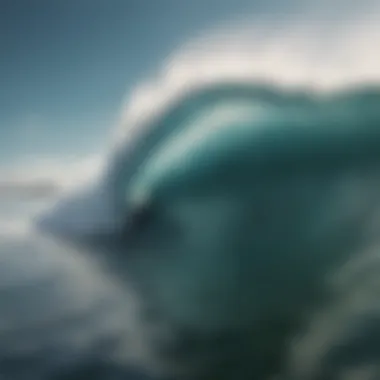
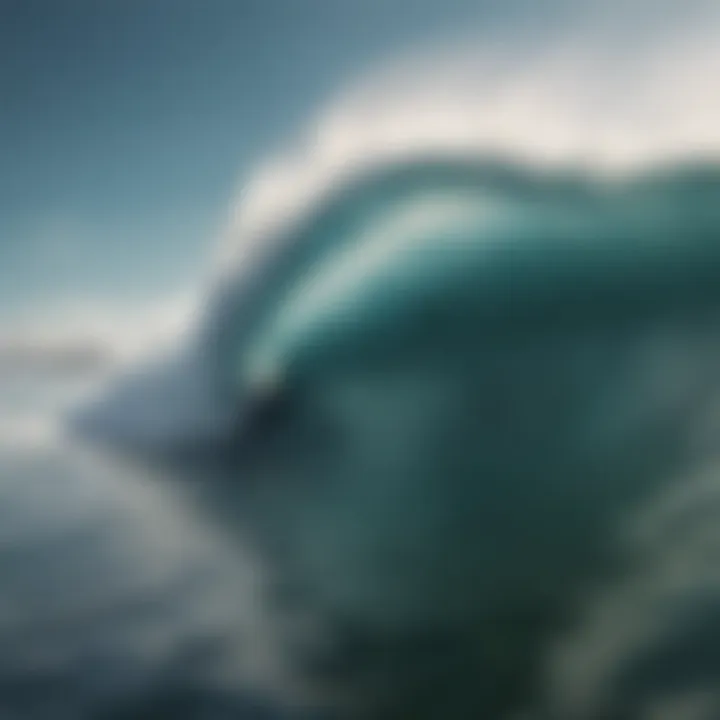
Intro
The ocean has always held a profound sort of magic for those who seek to ride its waves. Large wave art captures this essence, giving both the artist and the observer a way to engage with nature’s most powerful expressions. The intricate play of light on water, the roar of surging waves, and the adrenaline rush of surfing create a connection not easily put into words. Through various artistic styles and techniques, artists have ventured to depict the thrill and beauty found in surfing culture.
Large waves aren’t just a physical challenge for surfers; they symbolize life’s unpredictable nature. Each wave tells its own story, and large wave art invites viewers to immerse themselves in this narrative. As we dive into this exploration, let’s uncover how this unique art form communicates the blend of adrenaline, artistry, and emotional depth of the surfing experience.
Surfboarding Techniques
Understanding how to surf adeptly isn’t just about catching waves; it’s about encapsulating the thrill of the ocean while balancing art and athleticism. For both novice and veteran surfers, mastering surfboarding techniques is essential in enhancing one's experience on the waves. Here are tailored tips that cater to both beginners and seasoned surfers, ensuring that everyone can find their groove.
Beginner Tips for Mastering the Basics
- Choose the Right Board: Start with a longer and wider board. This helps with stability.
- Practice Your Pop-Up: The transition from lying down to standing is vital. Practice this on solid ground first.
- Learn to Paddle Efficiently: A good paddle technique makes all the difference in catching waves.
- Find a Suitable Surf Spot: Aim for beginner-friendly waves before tackling more challenging waters.
- Observe the Ocean: Take note of the tides, currents, and how waves break. Understanding these will help you catch more waves effectively.
Following these beginner guidelines can make the difference between a frustrating experience and a thrilling adventure.
Advanced Techniques for Seasoned Surfers
For those who have already mastered the basics, pushing boundaries means refining techniques and tackling bigger challenges:
- Carving and Cutting Back: Develop the ability to maneuver smoothly along the wave. This involves shifting weight efficiently on your board.
- Reading the Waves: Anticipating how a wave will break can help you position yourself better for optimal rides.
- Deep Bottom Turns: Low and controlled bottom turns allow you to enter maneuvers smoothly and maintain speed.
- Aerial Tricks: For the adventurous spirit, experimenting with airs and flips can provide an exhilarating sense of freedom and creativity.
Every surfer is unique, transforming the ocean into their personal canvas, and these advanced techniques open the door to more intricate artistic expression on the water.
Surfboard Equipment
Having the right surfboard equipment can drastically enhance one’s surfing experience. The relationship between surfers and their boards is intimate, allowing individuals to feel every rise and fall of each wave. Just as great artwork requires specific tools, so does surfing. Here’s a closer look at what’s essential.
Reviews of the Latest Surfboards on the Market
Recent innovations in surfboard design have revolutionized the surfing experience. Some notable names include:
- Lost Surfboards: Known for their cutting-edge designs that cater to different waves and surfing styles.
- Channel Islands Surfboards: Often favored by professionals, these boards have a reputation for high performance.
- Firewire Surfboards: They focus on eco-friendliness and sustainability without compromising quality.
Each brand brings something unique to the table, suitable for varying surfing levels and styles. As the ocean continues to enchant surfers, the boards they ride will also continue to evolve.
Essential Gear for Every Surfboarder
When hitting the waves, having the right gear is essential. Here’s a handy list:
- Leash: Prevents your board from drifting away after a wipeout.
- Wetsuit: Helps regulate body temperature, allowing for longer sessions in cooler waters.
- Surf Wax: Boosts grip on your board, essential for any surfer.
- Fins: These vary in size and shape, directly influencing performance.
"A surfer is not just someone who rides a wave; they are an artist who uses the ocean as their canvas."
The combination of artistic representation and technical proficiency is what makes large wave art resonate with both surfers and spectators alike, encapsulating the essence of a culture that thrives on the energy and beauty of the sea.
Understanding Large Wave Art
In the world of artistry, large wave art stands out not only for its visual appeal but also for its profound connection to nature and the culture of surfing. Understanding this form of art is crucial for comprehending how nature's might is reflected through creative expression. It captures not just substantial waves themselves but the emotions, stories, and memories that resonate with anyone who stands before this overwhelming force of nature.
Artists often delve into the powerful imagery of waves, which represent motion, change, and beauty amid chaos. The importance of large wave art lies in its ability to evoke feelings that range from awe to nostalgia, reminding us of our own adventures within the sea.
Defining Large Wave Art
At its core, large wave art can be described as any artistic representation that focuses on monumental ocean waves. These pieces might utilize various mediums, such as painting, photography, sculpture, or even digital formats.
The most iconic examples are often the paintings that portray crashing waves, saturated with blues, whites, and greens, almost appearing to leap off the canvas. Take the work of Hokusai, for example. His famous woodblock print, "The Great Wave off Kanagawa," captures the essence of a colossal wave in such a way that it resonates across cultures.
Large wave art goes beyond mere depiction; it becomes a vessel for emotions and ideologies. Artists use this imagery to critique environmental issues, celebrate surf culture, or convey the sublime nature of the ocean.
The Role of Nature in Artistic Creation
Nature plays an immense role in shaping large wave art—both as a subject and as a source of inspiration. Every wave has its own character, influenced by the wind, tides, and local geography. This rich interaction between natural elements gives artists a diverse palette to work with.
When artists observe waves, they aren’t just seeing water; they’re witnessing a dance of energy and motion. This kinship with nature brings about a certain humility, prompting artists to pay homage to the ocean’s power.
Artists often sketch or take photographs of waves as they surf or stroll along the shore. These firsthand experiences imbue their work with authenticity and personal connection. Furthermore, they highlight the cultural significance of the ocean in coastal communities, where surfing becomes both an adventurous pursuit and a spiritual practice.
"Art takes nature as a canvas, and the waves are its wild brush strokes."
Understanding large wave art intertwines with recognizing its roots in nature and the ways in which artists express their relationships with the ocean. Each wave captured is not merely a visual representation but an invitation to ponder our connection to the natural world and its art.
Historical Perspectives on Wave Art
Understanding the historical context behind large wave art sheds light on its evolution and significance within both art and surf culture. This section delves into how representations of waves have shifted from ancient times to modern interpretations. By studying these perspectives, we grasp not just the aesthetic qualities but also the emotional weight and cultural relevance that wave art carries today.
Ancient Representation of Waves
Waves have inspired artists for centuries, capturing the imaginations of countless cultures. In ancient civilizations, the sea was often seen as a symbol of both life and chaos. For example, the Greeks depicted waves in their pottery, showing both the serenity and the turmoil of the ocean. These depictions weren't merely artistic; they served as reminders of humanity's relationship with nature, with the fierce ocean representing the unknown.
Artisans in the East, particularly in Japan, created stunning woodblock prints portraying waves, such as Hokusai's famous "The Great Wave off Kanagawa." This piece goes beyond mere representation, intertwining nature’s raw power with human vulnerability. Such works reveal that the appreciation of waves is not just about their physical beauty, but also about the stories and emotions they evoke, capturing the awe and fear that oceanic forces instill.
The Rise of Modern Wave Art
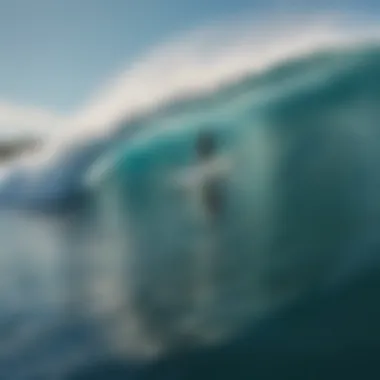
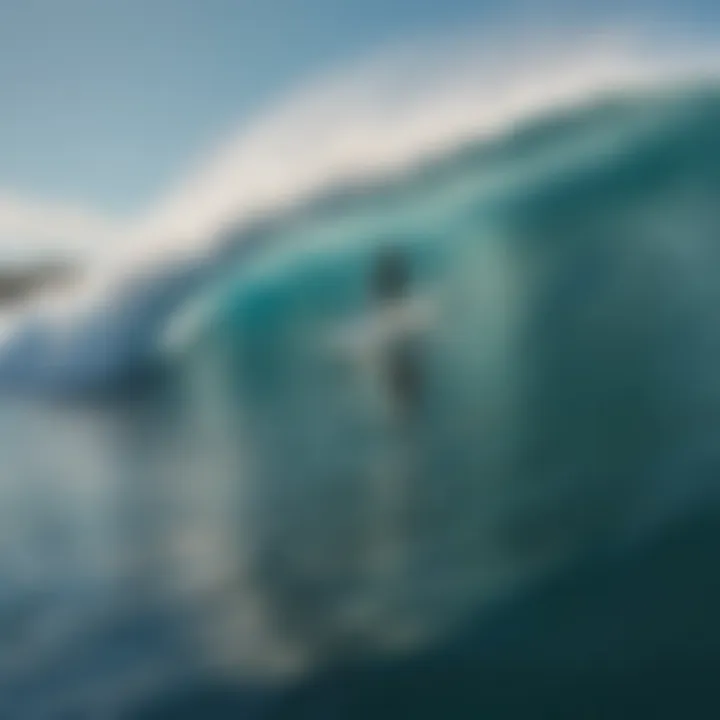
Fast forward to the 20th century, and wave art began to reflect broader cultural movements. With the surf culture boom in California during the 1960s, artists like Rick Griffin integrated waves into their avant-garde posters, merging them with the burgeoning surf scene. This period marked a departure from traditional landscapes to more vibrant and experimental interpretations of waves.
Moreover, modern techniques have expanded the methods used to portray waves. Artists now incorporate mixed media, digital platforms, and even environmental materials to express the ever-changing nature of the sea. For instance, some contemporary artists use resin to capture the translucence of water, making the artwork feel alive and dynamic.
"Ever since I was a kid, waves have represented freedom to me. Each piece I create is a reflection of that passion and a call to respect and preserve our oceans." - Anonymous Artist
Through this historical lens, one can see how wave art not only reflects the profound respect for the ocean but also serves as a conduit for dialogue about environmental awareness today. The transition from ancient depictions to modern interpretations highlights the evolving relationship between humanity and the sea, ultimately underscoring the importance of capturing its allure.
Techniques in Creating Wave Art
The creation of wave art is not just a matter of slapping some paint on a canvas or manipulating pixels; it’s a meticulous blend of tradition and innovation. Engaging with this topic is crucial as it reveals the intricate methods that artists employ to encapsulate the dynamic, almost fluid nature of large waves. Each brushstroke or digital manipulation reflects not only technical prowess but also a deep connection to the ocean, making it a vital topic for admirers of both art and surf culture.
Traditional Methods
When we look back at the roots of wave art, traditional methods come to the fore. Artists like Katsushika Hokusai, with his iconic print The Great Wave off Kanagawa, utilized woodblock printing techniques. This method is not just about reproduction; it holds the essence of craftsmanship and dedication. The way the artist carves into the wood, melding skill with intuition, allows for a unique expression of movement and energy.
In earlier waves, techniques like oil painting, watercolor, and even pastels had their time to shine. These techniques, though often labor-intensive, yield an authenticity that can be hard to replicate. The textures created on the canvas often mimic the very waves that inspire them. Using oil paints can create a rich, thick texture while watercolors yield a more fluid, ethereal quality. Each medium carries its history and depth, inviting artists to explore and experiment, pushing boundaries further each time.
Here are a few key considerations regarding traditional methods:
- Authenticity: Classic techniques often evoke a sense of nostalgia and connection to history.
- Skill Development: Mastery of these techniques requires time and dedication, reflecting the commitment of the artist.
- Material Choice: The selection of materials can deeply influence the final work, affecting not just aesthetics but also longevity.
Contemporary Innovations
As times change, so do the methods of creating wave art. Contemporary artists are diving headfirst into innovative techniques, blending traditional elements with modern technology. Digital art has surged in this domain, allowing artists to simulate the infinite variations of waves with a precision that’s hard to define. The possibilities with software like Adobe Photoshop or even 3D modeling tools are nearly limitless, which can be a double-edged sword. The ease of access to advanced tools can sometimes lead to an oversaturation of art that lacks distinct character.
Moreover, some artists are turning to sustainable practices, incorporating recycled materials into their pieces. This is not just about artistic expression; it’s an ethical stance reflecting the growing awareness of environmental issues linked to ocean conservation. For example, an artist might use reclaimed wood to craft a sculpture representing ocean waves, thus intertwining message and medium.
Overview of Contemporary Techniques:
- Digital Painting: Offers vast creative possibilities, allowing for detailed pattern and color manipulation.
- Mixed Media: Combines paint with other elements such as fabric or debris from the ocean, enriching the narrative.
- Installation Art: Engages the viewer physically, often utilizing sound and movement to mimic the ocean’s rhythm.
Through both traditional and contemporary lenses, the techniques in creating wave art offer a window into the evolving relationship between the artist, the ocean, and the audience. The exploration of these methods sheds light on how our understanding of the ocean’s power is continuously shaped by artistic expression.
"Art enables us to find ourselves and lose ourselves at the same time." - Thomas Merton
In well-captured wave art, whether traditional or contemporary, every detail is a reflection of the artist's journey and the ocean's relentless force. The convergence of these techniques ensures that the allure of large wave art continues to thrive in surf culture and beyond.
Key Artists in Wave Art
The realm of large wave art is rich with visionaries who have captured the exhilarating blend of power and grace that such colossal waves embody. Understanding the pivotal role these key artists play not only enhances our appreciation of the artwork itself but also deepens our engagement with the surf culture it represents. Each brushstroke or digital render carries with it not just aesthetic value but also a narrative that connects the viewer to the enormity of nature's force.
By examining the works of influential figures and emerging talents, one can see how diverse perspectives converge within wave art, showcasing different techniques, emotional responses, and philosophical interpretations. This variety helps craft an expansive landscape that reflects both the tumultuous ocean and the serenity that follows.
Influential Figures
To begin with, influential artists like Hokusai and Simon O'Connor stand as titans in the field. Hokusai's "The Great Wave off Kanagawa," created in the early 19th century, is a monumental symbol of wave art that continues to resonate with audiences worldwide. Its intricate details and tempestuous energy speak to the viewer, evoking a sense of awe and respect for nature's might.
On the contemporary front, Simon O'Connor fuses modern techniques with traditional marine themes. His pieces capture not just the physical beauty of waves but explore the dialogue between the ocean and human experience. As a surfer, his art is imbued with personal stories - tales of triumph, respect, and sometimes even loss. This intertwining of art and life adds layers of depth to the viewer's experience.
Moreover, Shinoda Toko, noted for her unique methods utilizing Japanese ink, brings a meditative quality to her interpretations of waves. In her work, the wave transforms from a mere visual phenomenon into a symbol of life's ebbs and flows, resonating with those who view it as a reminder of nature’s cycles.
"Art is not a thing; it is a way." - Elbert Hubbard
This quote resonates deeply within the wave art community, as artistry serves not just to replicate but to interpret and connect.
Emerging Talent
Emerging artists are stepping into the spotlight, bringing fresh perspectives to the established traditions. Among these talents, Katherine Whelan stands out with her ethereal digital wave paintings that utilize bold colors and textures to depict the emotional turbulence of surfing. Whelan’s art communicates a sense of freedom and adventure reminiscent of riding the waves.
Similarly, Rio Duran, a young muralist from a coastal town, has begun creating large-scale outdoor installations that celebrate not just surfing but also ocean conservation. His vibrant murals capture the essence of wave culture, while also raising awareness about the importance of protecting our seas. Duran's approach encourages viewers to draw a connection between art, surfing, and environmental stewardship.
Additionally, Leila Morales, whose minimalist style reflects calmness amidst chaos, explores the relationship between the human psyche and the ocean. Her works provide an introspective look at how waves mirror our emotions, making her a standout in the contemporary scene.
To summarize, key artists in wave art, whether established or on the rise, are pivotal in shaping the narrative around surf culture. Each artist offers a unique lens through which we can engage with nature's majestic waves. Their contributions not only beautify spaces but also inspire deeper connections and conversations about our relationship with the ocean, making their roles significant not just in art but within the broader framework of cultural expression.
The Emotional Impact of Wave Art
The emotional weight carried by large wave art is profound, resonating with viewers on multiple levels. These artworks don’t merely portray crashing waves; they encapsulate feelings of power, awe, and the mysterious nature of the ocean. The connection forged between the observer and the forces of nature becomes an integral part of the viewer's experience. Such art transcends mere visual appeal, delving into the psyche and stirring our innate reverence for the wildness of the seas.
Capturing the Power of the Ocean
In large wave art, the representation of the ocean’s force is a raw celebration of nature's might. Artists often draw inspiration from the tumult of crashing waves and the serene beauty that lies within their chaos. This can create a visceral experience for the observer, as the brushstrokes or digital patterns mimic the energy of the waves themselves. The swirling colors, the sharp contrasts between dark and light, all serve to convey an essence that embodies both danger and attraction.
- Sensory Overload: The viewer often feels a sense of immersion, as if they are right there among the waves. This feeling is heightened when art is placed in settings that invoke natural elements, such as homes near the coast or galleries with ocean sounds playing in the background.
- Symbolism of Waves: Waves can symbolize change and transformation. Just like waves ebb and flow, so do our lives. The tumultuous nature of large waves can remind viewers of their own struggles and triumphs, linking personal experiences to the broader narrative of nature.
A striking example can be seen in works by artists like Katsushika Hokusai, whose iconic The Great Wave off Kanagawa captures not only the furious power of a tsunami but also embodies the humbling relationship between humanity and nature. When audiences gaze upon such masterpieces, they often feel a complex mix of reverence, fear, and exhilaration.
"Art is the most beautiful of all lies," says art critic and theorist Jean Baudrillard, which rings true in the context of wave art where the portrayal of nature can be more impactful than reality itself.
Personal Connections with Nature
Beyond the aesthetic appeal, the emotional impact of wave art also lies in the intimate connections individuals have with nature. For many, the ocean is not just a body of water; it’s a source of nostalgia and personal history. Surf culture plays a pivotal role here, as surfers often have profound relationships with the waves they ride, leading to appreciation for art that captures those moments.
- Personal Experiences: Artists often relay personal stories through their works. A piece may remind viewers of their childhood adventures at the beach, the serenity of a tranquil sunset over the water, or even moments of solitude and reflection amidst nature’s grandeur.
- Healing Power of Nature: Interaction with art depicting waves can also provide a sense of calm. Studies have shown that art can evoke emotions linked to well-being and can serve as a therapeutic outlet. For enthusiasts of the ocean, gazing at wave art can evoke the salt in the air, the sound of crashing surf, and the feeling of sand beneath their feet.
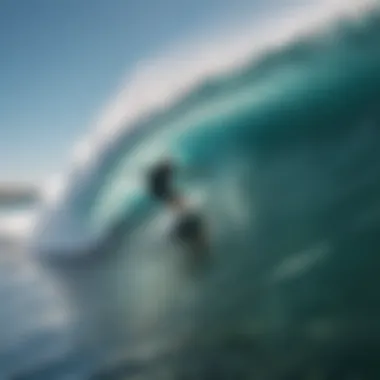
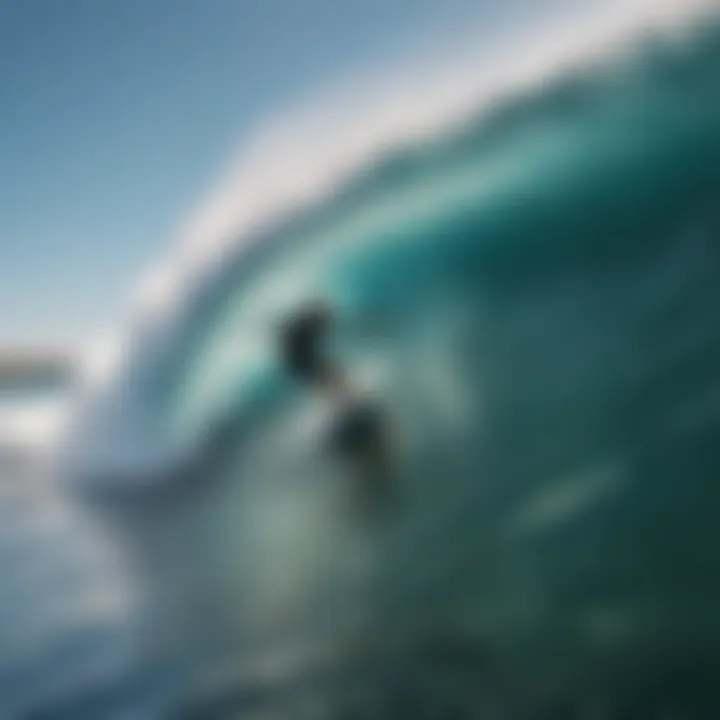
Sharing these emotions connects individuals to a larger community of sea lovers, fostering conversations and shared stories, ultimately reinforcing the bond between art, nature, and personal identity.
Wave Art and Surf Culture
The relationship between wave art and surf culture is one steeped in a rich history that intertwines the raw beauty of nature with the passion of human expression. This topic is vital to our discussion as it highlights how various artistic interpretations of ocean waves can influence and reflect the surfing community. A deep understanding of this connection not only enriches our appreciation of large wave art but also emphasizes its role in shaping collective identities among surfers.
Art, in essence, serves as a visual dialogue. In the context of wave art, this dialogue becomes a shared expression of values, emotions, and experiences tied to the ocean. Surfers often see themselves as more than just athletes; they become custodians of an incredible natural environment. Wave art acts as a bridge between the surfer's exhilarating experiences and a broader audience, capable of evoking powerful feelings associated with both adrenaline and tranquility.
Integration within Surfer Communities
Within surfer communities, large wave art finds a unique place. It is not merely confined to gallery walls but lives and breathes within local surf shops, competitions, and gatherings. Surf culture has always thrived on community; the hanging of a striking wave painting in a local surf hut can spark conversations about the ocean’s majesty or the importance of environmental conservation related to those very waves. These interactions foster a sense of belonging, as surfers rally around imagery that resonates with their experiences.
Art that captures the essence of monumental waves can also serve as a form of motivation, inspiring surfers to chase their personal limits. When talented artists paint colossal waves with vivid colors and dynamic motion, they create a compelling narrative that celebrates the spirit of surfing.
Moreover, many artists within the surfing community are surfers themselves, deeply connected to both worlds. This duality of identity allows for an art form rich with authenticity and passion. The creations often depict not just the physicality of the waves but the internal battles surfed by those brave enough to ride them. This is the essence of community spirit, where artistry and athleticism meld into one seamless expression of life along the water.
Influencing Surfboard Design
The connection between wave art and surfboard design is another significant aspect that cannot be overlooked. For many surfers, a board is not just a piece of equipment; it’s a canvas and an extension of self. Artists borrow their inspirations from wave art and incorporate those designs onto surfboards, resulting in unique and highly sought-after creations.
When looking at surfboards adorned with artistic representations of waves, one can see a fusion of functionality and aesthetics. Designers select colors and patterns that echo the waves themselves, resulting in a design that reflects the ocean's movement and energy. This synergy amplifies a surfer’s experience out on the water, as riding a board that visually embodies the waves can enhance their connection to the ocean.
Additionally, the designs on surfboards can foster individuality within the community. Surfers often use specific wave art as a way to express their style and to showcase their identity. A board designed with bright, swirling colors can be unmistakably recognizable in the lineup, allowing surfers to take pride in their unique boards while also paying homage to the waves that inspire them.
The narrative of wave art thereby influences the crafting of these boards - it transforms something utilitarian into a statement piece. In such ways, wave art and surf culture continually evolve and enrich each other, maintaining a dynamic loop of inspiration and creativity that resonates powerfully among surfers.
Environmental Themes in Wave Art
The relationship between art and the environment has grown more pronounced over recent decades, especially in the realm of large wave art. This section emphasizes the significance of environmental themes in wave art, focusing on how artists capture not just the beauty of ocean waves but also raise awareness about the pressing issues facing marine ecosystems.
Showcasing Ocean Conservation
Art has a unique way of conveying profound messages, and in the context of large wave art, this is particularly resonant. Artists use their platforms to showcase ocean conservation directly through their work.
Take an artist like Kelly Heaton, whose paintings evoke both the majesty and fragility of the ocean. Her vibrant depictions of colossal waves often encapsulate not only the power but also the perils of rising sea levels and marine pollution. By portraying majestic swells that surmount the canvas, she invites observers to encounter nature's might while simultaneously reflecting on its vulnerability.
This interaction between beauty and urgency cultivates a dialogue that encourages viewers to think about preservation. Artists often create limited edition prints, and a portion of the proceeds goes to marine preservation initiatives. This practice not only contributes to ocean conservation but fosters a sense of community among art collectors, surfers, and environmental activists.
"Art exposes facets of our world we might overlook. It awakens our consciousness towards nature's plight and beauty alike."
Sustainable Practices in Art Creation
Moving beyond the final piece, the journey of creating wave art also embodies sustainable practices. Artists increasingly embrace eco-friendly materials, ensuring that their artistic expressions do not further harm the environment. For instance, some use recycled paper or biodegradable paints, lessening their ecological footprint and contributing to the larger movement for sustainability.
Many institutions and art fairs now highlight the importance of sustainable creations.
- Biodegradable materials: Materials that decompose naturally over time, reducing waste in landfills.
- Water-based paints: These paints decrease air pollution and are less harmful to both the artist and the environment.
- Local sourcing: Supporting local suppliers reduces carbon emissions associated with transportation.
Moreover, workshops and art classes focused on sustainable practices are becoming more frequent. Educators emphasize responsible choices while encouraging budding artists to consider the impact of their materials. This progressive approach not only enriches the artistic community but also inspires the next generation to fuse creativity with ecological responsibility.
As artists take these steps, they not only contribute to the conservation of our oceans but also frame a narrative that intertwines art and awareness. Celebrating large wave art becomes synonymous with nurturing our planet, enforcing the idea that beauty can coexist with responsibility.
Collecting Wave Art
The pursuit of collecting wave art transcends mere aesthetics; it offers a profound way for enthusiasts to connect with the ocean and the culture surrounding it. Investing in pieces that depict the grandeur of waves allows collectors to embrace nature’s magnificence while supporting artists who capture this essence through their craft.
Buying Artwork: What to Consider
When venturing into the world of wave art, several factors should guide the decision-making process. Here are some critical elements to keep in mind:
- Artist's Background: Research the artist’s history and influences. Understanding their unique perspective on wave art can enhance the appreciation of the piece.
- Medium and Technique: Different artists use various mediums, from traditional oil paints to digital creations. Each medium comes with its own characteristics, which can affect the artwork's ambiance and atmosphere.
- Authenticity: Ensure that the artwork is original or, if it’s a print, check for certificates of authenticity. This validates the piece's value and exclusivity.
- Size and Space: Consider where the artwork will be displayed. Bigger pieces can create focal points, while smaller works might fit better in corners or alongside other art pieces.
- Resale Value: Though art should be a passion, it also serves as an investment. Some pieces may appreciate over time, enhancing their financial value.
A well-considered purchase not only adds beauty to a collection but also embodies a piece of oceanic spirit.
Curating a Collection
Curating a wave art collection is both an art and a science, allowing the collector to express their personal aesthetic while creating a cohesive narrative. Here are steps to effectively curate a wave art collection:
- Establish a Theme: Determine whether the collection will focus on a specific type of wave art, such as abstract interpretations, realistic seascapes, or contemporary digital works. A clear theme can provide direction.
- Diverse Representations: Include a variety of artists and styles to capture the many dimensions of wave culture. This variety keeps the collection intriguing and allows for a broader appreciation of the art form.
- Utilize Space Strategically: Arrange artworks in a way that enhances the viewing experience. For instance, position larger pieces in prominent areas while balancing them with smaller works in surrounding locales.
- Regular Updates: Collections evolve. Be open to acquiring new works that resonate emotionally or artistically, and consider rotating pieces in and out to keep the display fresh.
- Tell a Story: Aim to weave a narrative through the collection. Each piece can express different interpretations of the ocean, creating a journey for viewers as they explore your collection.
Collecting wave art is a journey that blends personal taste with a profound respect for nature. It doesn’t just adorn walls; it tells the story of our connection to the ocean.
By thoughtfully selecting and arranging artworks, collectors can create striking connections with the ocean’s power and beauty, enriching both their lives and the lives of those who experience their collection.
Exhibitions and Events Featuring Wave Art
Exhibitions and events centered around large wave art serve as dynamic spaces where creativity meets the raw power of nature. They bring together a community that thrives on both surfing and artistic expression. These gatherings do more than just showcase captivating artwork; they foster connections among artists, surfers, and enthusiasts, cultivating a shared appreciation for the beauty and ferocity of ocean waves.
Notable Exhibitions
In the realm of wave art, notable exhibitions often take center stage, attracting both prominent and emerging artists. Events like the "Oceanic Visions" exhibit highlight the intersection of nature and artistic interpretation, featuring works that capture waves in various forms—from photography to sculpture. For instance, the "Art and Ocean" installation in California draws thousands each year, displaying both contemporary pieces and classic interpretations.
Through these exhibitions, attendees can witness the unique styles and approaches different artists employ to depict waves. Some paintings capture the ethereal beauty of sunlight dancing on water, while others evoke the fierce intensity of a tempestuous sea. They often include:
- Live Demonstrations: Artists create their work on-site, providing insights into their process.
- Interactive Installations: Visitors can engage with the art, deepening their connection to the subject.
- Workshops: These allow attendees to try their hand at wave art techniques under expert guidance.
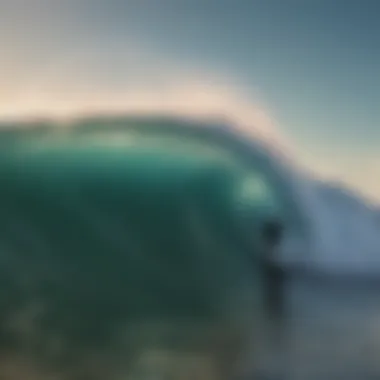
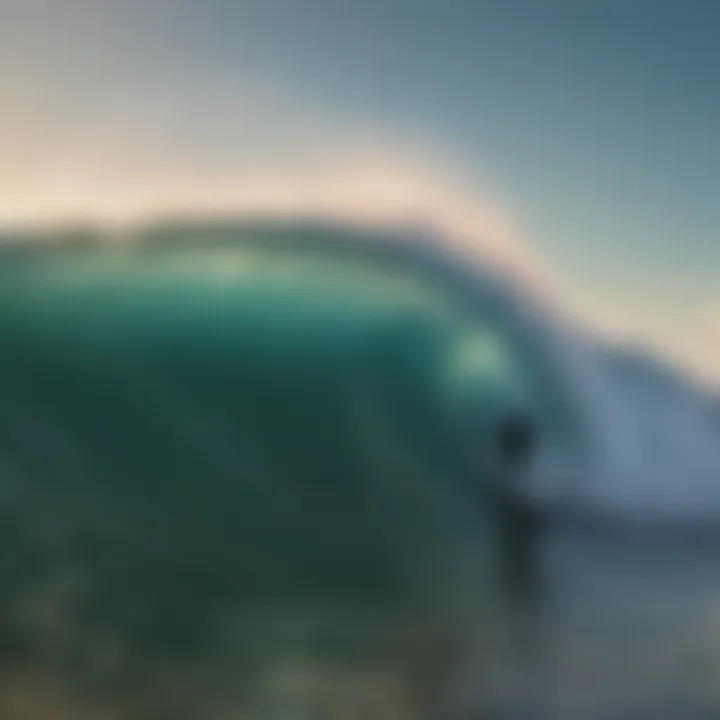
Such features make notable exhibitions more than mere showcases; they are immersive experiences that resonate emotionally and intellectually.
Annual Surf Art Festivals
Annual surf art festivals have become a staple for wave enthusiasts. Events like the "California Surf Festival" not only highlight art but also integrate the vibrant culture surrounding it. Here, local artists have the chance to display their creations alongside works from globally recognized names. This fusion of local and international artistry creates a stimulating environment where diversities in artistic expressions are celebrated.
During these festivals, attendees can expect:
- Film Screenings: Documentaries and short films about surfing and wave art.
- Panel Discussions: Engaging conversations with artists and surfers about their experiences and inspirations.
- Marketplace: Opportunities to purchase unique pieces, including original prints and surfboards adorned with artistic designs.
Surf art festivals play a crucial role in highlighting environmental concerns, often anchoring their themes in conservation efforts. In a world where oceanic health is becoming increasingly pivotal, such events raise awareness and inspire activism through art.
"Art can spark conversations that fuel action—by portraying the beauty of our oceans, we remind people of what’s at stake."
In essence, exhibitions and events featuring wave art not only showcase skill and talent. They incubate community, inspire environmental responsibility, and celebrate the unparalleled connection between surfing and artistic expression.
Digital Representations of Wave Art
In the realm of art, the digital age has ushered in new dimensions for expressing the beauty and power of large waves. This shift to digital representations carries weight in today’s artistic landscape. From the vibrant colors of digital brush strokes to the precision of graphic design, artists are utilizing technology to translate the natural drama of ocean waves into captivating visual pieces.
Digital representations allow artists to experiment with creative boundaries without the restraints of traditional mediums. The use of software programs like Adobe Photoshop or Illustrator enables them to create intricate designs that convey depth and movement, which can be harder to replicate using physical materials. This form of art also provides flexibility; modifications can be made with just a few clicks, allowing artists to refine their work in ways that were once labor-intensive or even impossible.
The accessibility of digital art is another significant element. Imagine capturing a surfer’s exhilarating ride on a wave and translating that moment digitally. Not only does this art reach a wider audience, but it can also be reproduced endlessly. Collectors and enthusiasts can access these pieces through social media platforms, art websites, or online galleries, making wave art more available than ever before.
As technology continues to develop, the importance of digital representations in wave art is only set to grow. Artists are able to share their interpretations more broadly, igniting dialogues about nature, surfing, and the emotional experiences tied to these subjects.
The Rise of Digital Art
Over the past couple of decades, digital art has seen a significant rise in popularity, coinciding with advancements in technology. As artists embraced computers and tablets as tools, a new path for creative expression emerged. Digital art is no longer seen as a lesser form of artistry but rather as a powerful medium that can stand alongside traditional painting or sculpture.
The advent of high-quality imaging and the proliferation of digital art platforms have spurred a vibrant community of creators. Some key points to consider include:
- Accessibility: Artists are no longer bound by the limitations of physical resources. They can utilize software programs to create stunning visuals with far greater ease.
- Networking Opportunities: Online communities such as those found on platforms like Reddit have fostered conversations around digital wave art, connecting artists globally.
- Creative Experimentation: Artists can play with colors, shapes, and sizes without the fear of a mistake being permanent. Erasing, layering, and adjusting elements based on feedback has transformed how art is created and shared.
In addition, as the world becomes increasingly digital, the audience for such art expands. With the ability to showcase featured works on websites like Facebook and traditional galleries evolving their practices to accommodate this new form of expression, digital wave art continues to grow in relevance.
Virtual Reality Experiences
Ah, virtual reality; once the stuff of sci-fi, now a gateway to unparalleled artistic exploration. VR technology has paved the way for a fresh perspective on wave art. It allows individuals to immerse themselves in an environment where they can experience the vastness of the ocean and witness waves crashing in a more engaging manner than traditional galleries could offer.
Imagine stepping into a world where each brushstroke you see in digital art morphs into a three-dimensional entity, allowing you to navigate through undulating waves as though you were a part of the scene itself. This multisensory experience offers a unique way to connect with art.
Here are a few noteworthy aspects of virtual reality as it pertains to wave art:
- Immersion in Nature: VR simulates the chaotic beauty of nature, allowing viewers to feel as if they are physically present among the waves. This alignment with the surf culture elevates the emotional impact of the artwork.
- Interactive Experiences: Users can manipulate elements of the art, perhaps even riding digital waves or altering their appearance, creating a personal connection with the piece. This level of interactivity is revolutionary in how audience engagement is approached.
- Enhanced Appreciations: Viewers can look at various angles and perspectives of the art they would typically miss within the confines of a traditional gallery space.
Virtual Reality experiences, while still developing, have begun to open up dialogues about how we view and interact with art in the digital age. They reflect a significant shift, embracing the fluidity of both wave art and technology.
The Future of Large Wave Art
As we move into an era marked by rapid environmental changes and evolving artistic expressions, the future of large wave art emerges as a fascinating confluence of creativity and conservation. This segment examines the critical aspects of future possibilities, highlighting how societal shifts and technological advancements are likely to shape the artistic landscape surrounding colossal ocean waves.
One of the significant elements to note is the growing inclination towards environmental awareness among artists. The allure of wave art isn’t solely about capturing the beauty of the ocean's force but also an invitation to reflect on its preservation. Artists are expected to increasingly channel their creativity into works that showcase not only the grandeur of waves but also ocean conservation themes, compelling viewers to consider their role in protecting marine ecosystems.
In addition, the integration of technology will play a pivotal role in shaping wave art's future. From augmented reality installations to digital canvases, the possibilities are as vast as the open sea. Artists are beginning to explore how advanced tools can help bring their grand visions to life, offering interactive experiences that engage audiences in ways previously unimagined. The fusion of art and tech serves to expand the accessibility of wave art, attracting a broader audience, including younger generations who are native to the digital realm.
"Art, like the waves, is in a constant state of flux, reflecting the changes in nature and society. As we adapt, so too must our expressions and methods."
This interplay between the traditional and the contemporary gives birth to an enriched narrative that not only honors the majestic power of waves but also aligns with the winds of change sweeping through artistic circles globally.
Trends in Artistic Expression
When it comes to the trends within large wave art, several currents can be observed. One abundantly clear direction is the move toward multi-dimensional imagery. Artists are now leveraging various mediums to create layered, textured works that compel viewers to look more intently, inviting deeper reflection on the subjects at hand.
Increasing prominence of abstract techniques
Some artists are leaning toward abstraction, where the portrayal of waves becomes more about emotional resonance than realistic depiction. For instance, vibrant, swirling colors might evoke a sense of chaotic energy characteristic of tumultuous seas rather than represent the waves directly.
Additonally, the emergence of collaborative projects is noteworthy. Artists are coming together with scientists and environmental groups to create works that not only inspire but also educate. These collaborations often reveal intricate stories about ocean currents, climate changes, and the life cycles of marine species, enriching the narrative surrounding wave art.
Potential Environmental Influences
As discussions surrounding climate change become more pronounced, they influence how large wave art is conceptualized and produced. Artists are anticipated to address pressing environmental issues through their work, highlighting the impacts of pollution, global warming, and the disappearance of marine habitats.
The urgency of these topics is pushing artists to find innovative ways to represent these themes. For example, utilizing recycled materials for their installations offers an impactful commentary on both waste and creativity. Meanwhile, installations that change with the tide can powerfully illustrate the transience of our oceans, showcasing how the very essence of wave art is intertwined with their environmental context.
In summary, the future of large wave art is alive with possibility, serving as a fusion of creativity, technological innovation, and environmental consciousness. It stands as a testimony of how art not only reflects but also has the potential to influence societal perspectives regarding nature's force.
Finale
As we draw the curtains on this exploration of large wave art, it’s only fitting to reflect on the profound relationship between art and surfing that emerges from our discussion. The waves, with their raw beauty and relentless power, have inspired countless artists to carve out expressions that resonate with individuals both on and off the water. Each artwork not only tells a story of nature's force but also honors the spirit of adventure that defines surf culture.
Reflecting on the Connection Between Art and Surfing
The interplay between art and surfing is a complex tapestry woven through shared experiences, emotions, and a collective appreciation for the environment. At its core, art created from the essence of waves serves as a bridge connecting surfers to their experiences and memories out on the ocean. Not to mention, it often reflects the emotional highs and lows that come with riding enormous rollers.
- Personal Reflection: For many surfers, encountering a stunning piece of wave art rekindles memories of their own encounters with the ocean – like the rush of riding a massive swell or the stillness of a sunset surf session.
- Community Identity: Additionally, these artworks are not just pieces to be hung on walls; they embody the identity and ethos of surf communities around the globe. Surf-inspired art serves as a badge of honor, signifying shared values of freedom, nature, and creativity.
One can’t overlook the environmental undertones interlaced within this genre of art, where the often harsh realities of climate change and ocean degradation find a voice through artistic expression. It’s a call to action for conservation efforts, a message that resonates strongly with the surfing community, which holds the ocean dear.
In summary, as broader cultural shifts seek a deeper connection with nature, large wave art stands at the forefront, representing not just a visual feast but also evoking critical conversations around our relationship with the environment. This intersection of art and surfing is not merely decorative; it is a movement encouraging reflection, connection, and action. Collectively, they inspire us to embrace the rhythm of the waves – both in life and in art.















